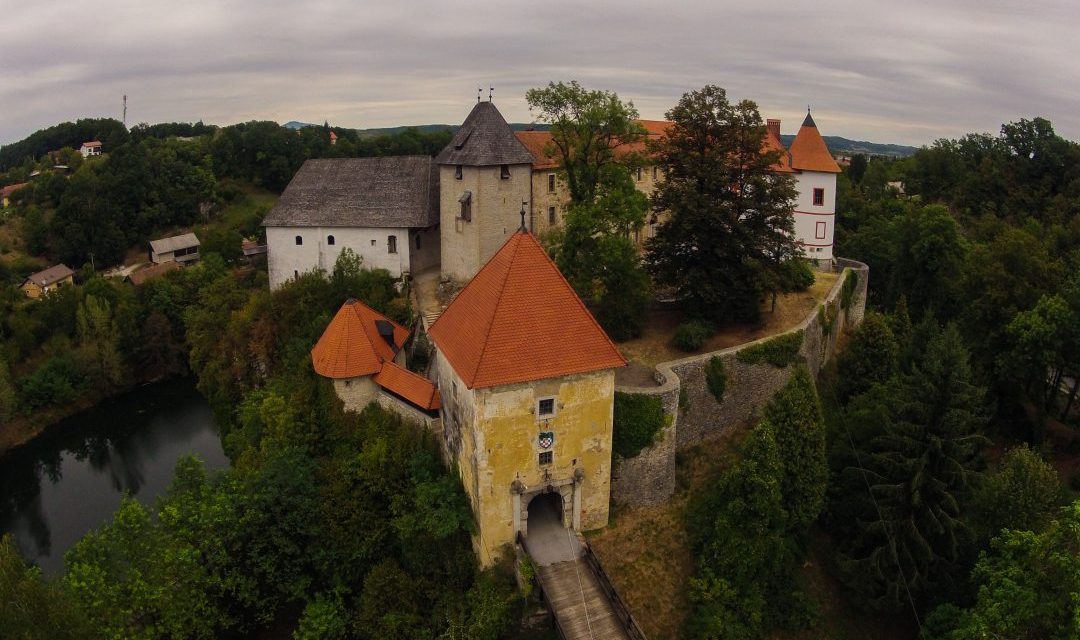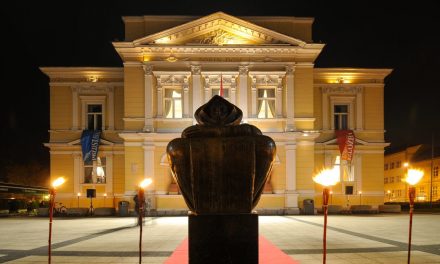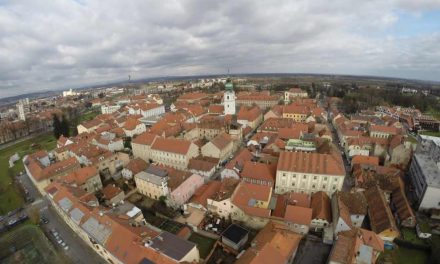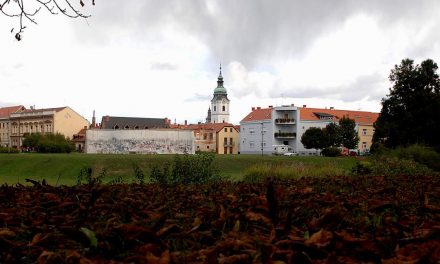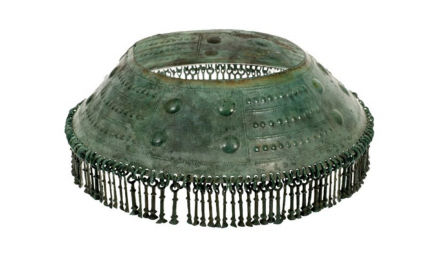The famous walls of Modruš
The history of Modruš extends to ancient times. The medieval fort rose on the prominent conical hill (678 m above sea level), and the suburb was surrounded by 1200 meters of fortified walls (the second longest in Croatia next to the walls of Ston). Prior to the fateful battle at Krbavsko Field in 1493, Modruš was the most important centre of Frankopan property extended from Primorje to the Sava River. An important roadway that passed through the ruins connected the port of Senj with hinterland Croatian. Modruš was one of the few places in the country where the medieval thirtieth was charged, a form of customs duties. The settlement still exists, but only ruins of the structure remain.
Unofficial Croatian capital
The fortified Town of Ozalj sitting on a cliff above the Kupa River is one of the most picturesque places in Croatia. Archaeological findings testify of the settlement long before 1244, when the name of the town was first recorded. In the mid-17th century, it was the unofficial capital of Croatia; the seat of ban Peter Zrinski, and it was the Ozalj literary-linguistic centre. Today, there is a Heritage Museum with priceless archaeological, cultural, historical, sacred and ethnographic collections. As a whole building complex, the city is marked as a single complex by the old Romanesque tower (Babonić Tower), bulwark with semi-towers, a Gothic-Renaissance palace, which was built in the 16th century by Ban Nikola Zrinski (one of the largest Croatian heroes, killed in battle at Siget in 1566) and it also has spacious baroque wings.
A fortress conquered the most times
During the Middle Ages, under the rule of Frankopan, Croatian Parliament was held in the Cetin Fort in 1527, in which Ferdinand of Habsburg was elected as the Croatian ruler. From the 17th to 19th century Cetin, during heavy fighting, it passed from Croatian into Turkish hands. Since 1865, it has become a ruin, but still preserves its architectural remains, mostly Turkish, and somewhat less from the Krajina era. Krešimir Baranović composed the opera “The Bride of Cetinjgrad” (which premiered in 1942 at the Croatian National Theatre in Zagreb) and is based on the novel by August Šenoa titled “The Turks are Coming,” where the scene is placed in Cetin.
A quarry town
Historians assume that Steničnjak near today’s Donji Sjeničak not far from Karlovac was built in 1105 as capital city of the medieval Croatian County of Gorica. The owners were its nobles and Babonićs and Frankopans. Here, sessions of Croatian Parliament was held on a number of occasions. The fort was abandoned until the 17th century because of the Turkish threat and became the source of stone for the surrounding buildings and reconstruction of Karlovac.
From fortress to museum
Although Dubovac is among the best preserved monuments of feudal Croatian architecture (probably built in the late 12th or early 13th centuries), it provides strong archaeological evidence of permanent settlements, particularly during the Bronze Age. In the invasion by the Ottomans, it was not conquered. In the period from 1968 to 2002, it served as a hotel providing accommodation for famous statesmen. Today, Dubovac has retained the majority of its characteristics that it had when owned by the Frankopans and Zrinski in the 16th century. Its defence tower is the best vantage point from Karlovac, and accommodates exhibitions from the City Museum. At the end of May, it is a host of tourist events called the “Feudal Manor Exhibition,” which revives the old markets where paths from coast and inland Croatian had intersected.
Fortress defended by water
The fortified town of Ribnik is the only preserved lowland ‘Wasserburg’ (German name for a city with a water-filled moat) in this part of Croatia, where fortified medieval towns were mostly located on elevated sites. The Ribnica Estate is mentioned in the 13th century during the time of the Babonić Dukes.
Today’s appearance of the city mostly results from the heritage of Bernardin Frankopan from the 16th century. The former defensive water-filled moat served as a pond, after which the town got its name. The Turkish army did not conquer Ribnik.
Six centuries of survival
Thanks to Katarina Frankopan’s grant, in 1404 the Order of Saint Paul the First Hermit founded monastery in Kamensko, along with the Church of St. Mary of the Snow. The Paulines or ’white monks’ abandoned the monastery on a number of occasions due to Turkish invasions and the abolition of the Order in 1786. They returned in 1972. Destroyed in the Croatian Homeland war, by 2008 the monastery was rebuilt. In the charisma of the Paulines from Kamensko, well-noted devotions include honouring the Blessed Virgin Mary and praying for protection of unborn children.
Monumental Gothic shrine
In the parish Church of the Blessed Virgin Mary of Miracles in Oštarije stands the greatest monument to Croatian Gothic sacral architecture outside of Zagreb. The church, which was never completed, was raised by Stephen II Frankopan around the year 1450. The largest medieval Croatian church (52.5 m by 20 m) was destroyed by the Turks in 1521. In 1902, a new church was built over the preserved Gothic sanctuary.
Kaštel over the Dobre abyss
A Renaissance fort – the Ogulin castle was erected about 1500 by Bernardin Frankopan, the owner of the nearby damaged Modruš. It rises above the Đulas abyss and was once called the city of Jula. The The castle accommodates the Heritge Museum which contains archaeological, ethnographic, mountaineering and alpine collections including a collection of old weapons, a memorial room dedicated to the writer Ivana Brlić-Mažuranić and an exhibition of works by the painter Stephen Galetić (both born in Ogulin).
National cultural monument
The Church of the Holy Trinity and the Franciscan Monastery in the central square in Karlovac are national cultural monuments. The parish Church of Holy Trinity is one of the few set points in the system of streets and blocks recorded in the earliest draft of Karlovac from 1579. Today’s whole complex was made mostly through the contribution of the Franciscans who assumed the parish in 1657 and began construction of the monastery the following year. The church is a single-nave structure with side chapels, while most of the beautiful baroque altars arrived from Slovenian workshops. The 44-meter high bell tower evolved from a defensive tower. One wing of the monastery, once primarily a school, accommodates a museum of sacral art.
New Pauline monastery
Above the vineyard slopes of Vodenice near Ozalj, there is a spacious Pauline Monastery of the saint dating back to 1626, and the most known prior was Ivan Belostenec, the person who ordered its construction, and whose patron (protector) of the monastery was Frankopan. Behind the massive walls of the Church of the Nativity of the Blessed Virgin Mary is an interior containing magnificent Baroque altars. Below the church there are burial niches carved into the walls. Ivan Belostenec is best known as the writer of ‘Gazophylacium’, a great Latin-Croatian dictionary (manuscript from 1675, which also assembled the linguistic treasure of all three Croatian dialects).
The Monastery of the Order of the Daughters of the Sacred Heart
The only Croatian monastery of the Order of the Daughter of the Sacred Heart is to be found in Lasinja. The women’s order was established in Belgium in1873 by Mary-Deluil Martiny (Mary of Jesus). In 2007, the nuns moved in the newly built monastery in Lasinja, fulfilling the long desire of Cardinal Aloysius Stepinac for the sisters to come to Croatia. Besides the monastery, there is also the Church of the Sacred Heart.

